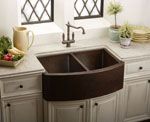
In generations past, most sinks were cast coated with enamel. They were durable, but offered few design options. And today’s enamel surfaces are more prone to scratching because there’s no longer any lead content. Luckily, homeowners now can choose from an array of materials, colors and shapes. Copper (shown) is appealing because its beautiful, recyclable and its patina eventually covers scratches.
Sizing Up Your Sink
If you’re remodeling and you’ve chosen everything but the proverbial kitchen sink, then you still have work to do. Sink-shopping isn’t as simple as it sounds. There’s a tremendous variety on the market and you need to do some homework before making a decision.
First, consider the kitchen’s overall style. Is it casual/everyday, contemporary, modern, period, regional, transitional or imaginative? Or are you choosing a sink for a utilitarian work area, such as a laundry room or a garage? Whatever the style of the kitchen, there’s a sink to match it.
But what should the sink be made from? Sinks these days use materials ranging from cast iron to concrete, and all have distinctive characteristics.
Cast iron, for example, was once the standard for kitchens. While it has a long life it’s also prone to defects
and damage resulting in rust. Cast iron sinks also have less bowl capacity and offer limited design options.
And the enamel surfaces, which aren’t as hard as they used to be because they no longer contain lead, are easily scratched. Clean cast iron with a soft cloth and don’t leave staining materials in contact with the surface for extended periods of time.
Concrete, on the other hand, is heat- and scratch-resistant and offers an array of color and texture options. It can be molded into any shape to fit any style, and damage, such as chipping or stains, can be professionally sanded. However, concrete should be waxed and buffed weekly using bee’s wax. Avoid abrasive cleaners.
Copper is a warm, organic and naturally sanitary material that’s scratch- and erosion-resistant. It’s also 100 percent recyclable, making it an environmentally responsible choice, and the surface is, for the most part, self-healing, meaning that it eventually patinas over scratches.
Clean copper with a mild detergent and a soft cloth while particularly stubborn stains and tarnish can be eliminated with a quality copper cleaner. Avoid harsh alkaline- , ammonia- or acidic-based cleaning solutions and never use abrasive cleaners or scouring pads.
Fireclay, the oldest material on the market, is resistant to acid, water and most solutions and is extremely durable. It, too, can be molded into any shape. And although color options are limited, it can be hand-painted. Any general-purpose cleaner can be used on a fireclay surface.
Granite composites, the components of which include quartz, feldspar and mica, are durable and discoloration-resistant. Not all composites are created equal, however. Binding material may be either polyester or acrylic resins. Ask for acrylic resins, which are superior.
But be careful not to set hot pans on the surface and run cold water when pouring hot water down the drain. Clean granite composites with soapy water and a sponge and avoid exposing the surface to strong chemicals such as paint removers and oven cleaners.
Stainless steel offers timeless beauty and comes in many shapes, sizes and depths. It’s recyclable, sanitary, easy to maintain and is offered in a variety of types and finishes. It can be cleaned using an ordinary mild detergent and a soft cloth and light scratches blend over time into the finish pattern. Don’t use steel soap pads because particles can adhere to the surface and eventually rust.
The gauge, or the thickness of the stainless steel, is important. The lower the gauge number, the thicker the material—and thinner material is more prone to denting and bowing.
If it all seems overwhelming, ask your contractor or your kitchen design professional for guidance.
